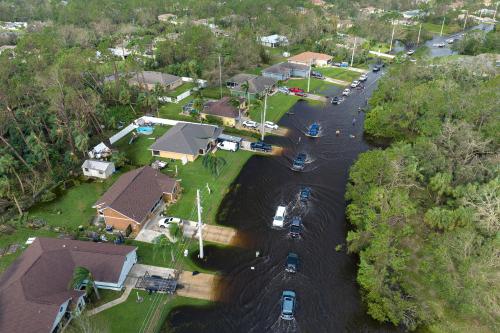Last week President Obama made good on a campaign promise to consider California’s request for higher automotive fuel efficiency standards. If the Environmental Protection Agency grants California’s request to adopt standards more stringent than pending federal requirements, at least 13 other states will likely follow California’s lead to require a nearly 30 percent reduction in greenhouse gases from tailpipes by model year 2016, or an average of about 42 miles per gallon by 2020. Current federal law would require an average fuel economy of at least 35 miles per gallon by 2020.
The president hails greater fuel economy as a way to reduce our dependence on foreign oil and to protect the climate. However, an important question about fuel efficiency standards is whether an increase in the standard to the level California proposes is the best way to protect the planet, particularly once a more comprehensive plan to control greenhouse gases is in place. As part of his overall climate change agenda, the president vowed to achieve 1990 U.S. greenhouse emissions levels by 2020 and 80 percent below that by 2050. During his campaign, President Obama proposed a cap and trade system as the primary means of achieving these targets, and Congressional Democrats plan on taking up such legislation this year. Other legislators have called for a broad tax on the carbon content of fossil fuels to achieve emissions goals. Regardless of its final form, most observers expect Congress to pass some version of comprehensive climate protection early in the Obama administration. Given that an economy-wide climate bill is likely forthcoming in the next two years, do higher fuel economy standards or other regulatory measures now make sense?
Proponents argue that higher fuel economy standards are part of the climate solution. But once the emissions caps are set and firms are trading rights to emit, fuel economy and other regulatory standards produce no incremental climate benefits. The very nature of cap and trade means that if vehicles in California emit less carbon, other sources, including motorists in states that stick to the federal fuel economy standards, can emit more. So the California waiver can influence where the reductions take place, but not the overall national greenhouse emissions level. Because mandating greater automotive fuel efficiency tends to be a more costly way to reduce emissions than other methods, the California rules could only end up increasing the cost of achieving the emission target without providing additional climate benefits. Indeed, the waiver could inadvertently undermine overall climate benefits if the stringent vehicle rules prompt legislators to exempt transportation fuels from the cap and trade program, as Representative John Dingell (D-MI) has already proposed.
The climate benefits of other green energy programs on the table this year will likely also evaporate when a cap and trade system starts up. For example, the Chairman of the Senate Energy Committee, Senator Bingaman (D-NM), favors a national renewable portfolio standard (RPS) that would boost the market share of wind, solar, and other renewable electricity options to 15 percent by 2020. The proposal is meant to give renewable energy firms a guaranteed return on investment and to help drive down the cost of renewable energy. But even if the cost of solar power, for example, falls from current levels, the RPS won’t make the renewable technology compete with potentially cheaper ways to reduce emissions, such as increasing energy efficiency or switching from coal to natural gas to produce electricity. The RPS would not spur development of carbon capture and storage, and again, once the U.S. has an emissions cap in place the RPS can only raise the cost of achieving the climate goal without doing anything to strengthen it.
The California standards and the RPS have plenty of supporters. Some argue that regulations are needed on top of a comprehensive climate program because economy-wide measures wouldn’t lower emissions enough in certain sectors. But in the atmosphere all carbon dioxide is created equal, and the climate benefits are the same no matter where the reductions are achieved. Even if the U.S. adopted a greenhouse gas tax instead of cap and trade, incrementally tight fuel economy standards and an RPS would likely be more costly than the same emissions reductions spurred by a slightly higher tax. In this struggling economy, why pay more than necessary to address the problem?
Some support the regulatory standards because they further non-climate policy objectives, such as promoting energy independence. Fair enough. But California’s waiver would regulate tailpipe pollution under the Clean Air Act — a law that has nothing to do with energy independence. An RPS will do little to promote energy independence because electricity fuels are nearly all domestic; less than 2 percent of U.S. electricity is generated with oil. And neither approach would work as well as a phased-in tax on oil that reflects its geopolitical cost. As unpopular as new taxes may be, it is exactly this sort of hard choice that is necessary to prepare the nation for a new age.
Others support climate-protecting regulatory standards because with those measures in the baseline, the estimated costs of a cap and trade program will be lower when Congress finally takes up the plan. Such efforts to obscure the overall cost of protecting the climate will likely fail, undermine the credibility of Congress, and weaken the consensus for action. The president has made a laudable commitment to transparent and scientifically sound policy, and Congress should follow suit, starting with climate protection strategies.
So if stiffer regulatory standards aren’t necessarily the best way to protect the climate, what should the president do? First, the administration should deploy the green energy dollars in the stimulus bill wisely, seeking the greatest emissions reductions per dollar along with creating jobs. Second, it should invest in basic research and development of green technologies and tools to adapt to a disrupted climate. Third and most important, the administration should not delay in adopting a comprehensive economy-wide price signal to reduce greenhouse gas emissions. While policymakers may hesitate during a crisis to burden the economy with emissions abatement, a program that starts modestly and stays credible is feasible, even in a major recession. Either a cap and trade system or greenhouse gas tax can work, but President Obama should plow the potentially massive value of allowances or tax revenue (estimates begin at $100 billion per year and rise sharply with more stringent goals) back into the economy in a way that supports growth and protects the poor. Firm expectations that the price of polluting is going up will point the economic recovery in the right direction.
The Brookings Institution is committed to quality, independence, and impact.
We are supported by a diverse array of funders. In line with our values and policies, each Brookings publication represents the sole views of its author(s).



Commentary
Op-edFuel Efficiency Standards: A Detour from the Cheapest Climate Protection
February 3, 2009